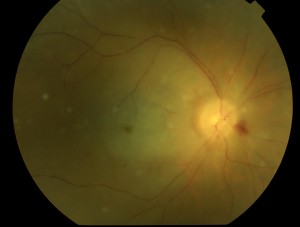Retinal Artery Obstruction
What Is Retinal Artery Obstruction?
 You have been diagnosed with a retinal artery obstruction. The loss of vision which you have experienced is the result of a blockage in blood flow to the back of the eye where the retina is located. That part of the retina which has lost its blood supply abruptly ceased to function and left you with a visual impairment. Depending on the extent and location of the retina affected, the loss of vision may be relatively mild or quite devastating. This problem, in effect, is like a stroke of the eye.
You have been diagnosed with a retinal artery obstruction. The loss of vision which you have experienced is the result of a blockage in blood flow to the back of the eye where the retina is located. That part of the retina which has lost its blood supply abruptly ceased to function and left you with a visual impairment. Depending on the extent and location of the retina affected, the loss of vision may be relatively mild or quite devastating. This problem, in effect, is like a stroke of the eye.
What Treatment is Available?
In general, there is no treatment for patients with a stroke and that includes a retinal artery blockage. Sometimes there will be a substantial improvement in vision, but this usually will occur in the first several hours, at most a few days, after the blockage develops. There is no treatment which has been shown to be helpful in improving the vision.
Can the Condition Worsen?
Sometimes patients with a retinal artery obstruction develop a severe form of glaucoma which can completely eliminate vision and cause the eye to be red and painful. Although uncommon, this glaucoma is quite severe. Usually, warning signs will develop within the eye before the glaucoma sets in. You will need to be checked carefully over a period of several weeks or months to look for these warning signs. If they should develop, your doctor will recommend a laser treatment to try and prevent severe glaucoma. Please understand the laser treatment does not help to improve vision, but rather, significantly reduces the development of glaucoma. These warning signs are usually without symptoms, and it is critical that close, careful follow-up be maintained. Laser has no other role to play for this problem.
Do I Require Further Testing?
In general, patients with either a “center” (the main artery) or “branch” retinal artery obstruction require an evaluation to look for a source for the blockage. Often the blockage is the result of hardening of the arteries with a fragment of cholesterol or clot breaking off to from a large vessel (such as in the neck or heart) and floating down stream until it happens to obstruct a smaller vessel in the eye.
An evaluation by your family doctor, internist, or cardiologist is usually very helpful in trying to identify the source. Blood tests or other diagnostic tests such as an ultrasound of the heart and neck may be appropriate. Sometimes a blood thinning medication such as aspirin is helpful to prevent any further clots and blockages from forming. This does not help to improve the sight in the affected eye but could have a long-term benefit for you.
Are there any restrictions or precautions?
There is no reason to limit one’s activities, to avoid reading, to avoid watching TV, etc. However, when one has blurred vision in one eye for any reason, one’s depth perception is hampered. To the degree that this is true, one should be careful doing anything which requires the ability to judge distances such as working around machinery, climbing on ladders and scaffolds, pounding nails, pouring hot liquids, and driving. It is relatively uncommon for a similar process to affect the other eye, and blurry vision in one eye does not in any way harm the “good” eye.
If you have additional questions or concerns, please ask the doctor or a member of our staff.
